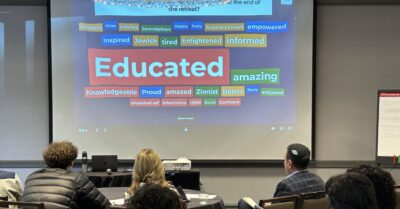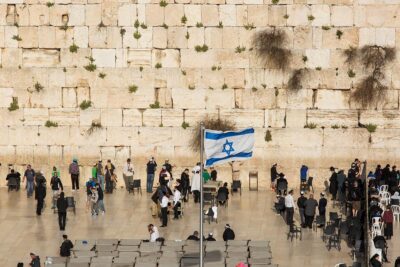Editor’s note: A longer version of this article by Sarah Gordon originally appeared in the Panim Journal. Reprinted with permission.
It is now officially “acharei hachagim” (after the holidays) and schools are getting back into routine. As students and teachers return to the classroom, November — Israel History Month — is a great time to be thinking about how schools approach teaching Israel.
While much has been written about the importance of nuanced or “commitment and critique” Israel education, there is still the question of what this approach looks like practically and how to manage the difficulties that arise when implementing it.
I will share some practical perspectives from the field, including some best practices educators can use when bringing these methods into the classroom.
1. Support hesitant educators.
Educators are often hesitant about implementing a more nuanced approach, out of fear that opening up complex discussions about Israel could lead students to turn away from Israel and Zionism.
A nuanced approach opens educators up to new levels of vulnerability where they may not know what to do when a student shares an opinion questioning Israel’s actions or legitimacy. Teachers may also be nervous about possible repercussions from parents and administrators.
To address these concerns, educators can learn from alumni about how these types of conversations help prepare them for encountering the “real” Israel, embracing both Israel’s strengths and flaws, which ultimately strengthens their relationship with the Jewish state.
Additionally, schools must recognize that not every teacher is comfortable leading nuanced class discussions. Many teachers would benefit from training, good mentorship, and access to a larger community of Israel educators grappling with the same issues.
The Unpacked for Educators Collaborative program is one example of a way to provide the support and scaffolding needed for educators to gain confidence in navigating these difficult Israel conversations.
Finally, educators also need to know that they have the support of their administration in case any pushback arises and that their jobs are not in jeopardy. Educators can ask administrators to sit in on more controversial class conversations to provide further support should a parent call with a concern.
2. Provide opportunities for reflection.
Teachers are not the only ones who might struggle with a nuanced approach. Depending on the setting, some students could also feel uncomfortable with the difficult questions raised in discussions and sources.
If students already identify as Zionists, what does it mean for their identity if suddenly they find themselves disagreeing with Israeli policy? Here, significant time must be allocated for student reflection, which can happen through class discussions, writing prompts, or one-on-one meetings.
To address this concern, educators could begin by inviting students into the process. An introductory unit could cover the different approaches to Israel education along with their advantages and disadvantages. Students could share their comfort levels with each one. The teacher could also share why he or she is using a nuanced approach.
3. Give your students an opportunity to empathize with different perspectives.
It is important to clarify that the goal of a nuanced approach is not to change anyone’s politics but to help students develop empathy. This gives students the agency to think through all sides of an issue and formulate their own informed opinions.
One way to foster empathy is to expose students to the experiences of real Israelis on all sides of the conflict and political spectrum, including IDF soldiers, Jewish settlers, Arab citizens of Israel, and relatives of students who currently live in Israel.
When the conflict heats up between Israel and Gaza, students can hear perspectives from families living under rocket fire in Sderot as well as what life is like for Palestinian civilians in a war zone.
Hearing first-person narratives complexifies the conflict beyond a black-and-white binary, allowing students to formulate their own views while hearing, empathizing and understanding different perspectives.
4. Move from a siloed to a holistic model.
Even when a school decides to adopt a nuanced or “commitment and critique” approach to Israel education, this message can get drowned out by the multitude of other messages about Israel happening simultaneously in the school.
Diverse models can be wonderful and show the need for multiple voices in a school, but it is rarely done clearly. Instead, students can get contradictory messages from different history courses, Israel clubs, school-wide speakers, and Yom HaZikaron and Yom Ha’atzmaut commemorations.
Schools can minimize confusion by naming the different approaches and separate goals of each division. Perhaps the role of co-curricular speakers is to focus more on positive Israeli culture, while official Israel courses introduce more nuance.
Additionally, Yom HaZikaron and Yom Ha’atzmaut are the perfect days to model serious Zionist commemorations and celebrations with thoughtful programming on the complexities surrounding the State of Israel.
5. Use a “Mikraot Gedolot” approach to Israel education.
My colleague, Dr. Noam Weissman, makes the argument for a “Mikraot Gedolot” approach to Israel education. Just as a volume of “Mikraot Gedolot” contains a wide range of different biblical commentators with diverse opinions, a similar model should be applied to Israel education.
This is consistent with the history of Zionist thought. Zionism has never been monolithic but has encompassed multiple schools of thought. (For more on this, check out our article and resources, “There’s no one way to be a Zionist: Six different types of Zionist thought, Part 1 and Part 2.”)
What a “Mikraot Gedolot” approach looks like will be different for every school. Each school will have its own comfort level surrounding the discourse around Israel and which perspectives fall within the bounds of the Zionist debate. This can get especially thorny with regard to complicated political issues such as the settlements and how some schools celebrate Yom Yerushalayim (Jerusalem Day).
Teachers can also use this approach to explore the Knesset with their students, and the vast range of opinions that exist within Israeli democracy. This is also a wonderful go-to approach to engage students in any topic in Israeli history or current events, presenting students with multiple perspectives on each issue.
6. Include parents and community members in the discussion.
Introducing nuance and complexity into discussions about Israel can extend outside of the classroom to parents and the greater community. As educators, we have an opportunity to facilitate these important conversations not just in our schools, but in our communities as well.
Teachers should encourage students to share the questions that arise in class at their Shabbat tables. Schools can also run events for parents and the greater community by screening different films that balance strong Zionist messages with difficult questions.
Bringing the parents and community into these important conversations is crucial for the discourse we want to see take place, especially on a topic as central as Israel.
Conclusion
Introducing nuance and complexity into an Israel curriculum is no easy task. It is a work in progress in day schools and supplementary schools, which is why discussions about best practices are so important for schools to have.
Despite the challenges, the best advocates for this approach are alumni of schools that have adopted it, who share how leaning into the hard questions did not push them away from Zionism but helped strengthen their love for Israel. Ultimately, it prepared them for the challenging discourse surrounding Israel in the adult world. Simply put, “good Israel education is good education” and we have our work cut out for us.
Sarah Gordon is Unpacked for Educators’ Senior Director of Israel Education for the Americas.





